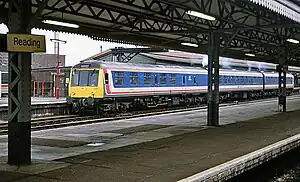| British Rail Class 119 | |
|---|---|
 119 L575 at Reading in 1992 | |
| In service | 1958–1992 |
| Manufacturer | Gloucester Railway Carriage & Wagon Co. Ltd |
| Replaced | Steam locomotives and carriages |
| Constructed | 1958 |
| Number built | 84 cars |
| Number preserved | 3 cars |
| Number scrapped | 81 cars (26 DMBC, 27 DMSL, 25 TSLRB) |
| Formation | DMBC-TSLRB-DMSL |
| Capacity |
|
| Operators | British Rail |
| Lines served | Western Region |
| Specifications | |
| Car body construction | Steel |
| Car length | 64 ft 6 in (19.66 m) |
| Width | 9 ft 3 in (2.82 m) |
| Height | 12 ft 8+1⁄4 in (3.87 m) |
| Maximum speed | 70 mph (113 km/h) |
| Weight |
|
| Prime mover(s) | Two BUT (AEC), then BUT (Leyland 680-1595) of 150 hp (112 kW) per power car |
| Power output | 600 hp (447 kW) per 3-car set |
| Transmission | Mechanical |
| HVAC | Oil-burning air heater |
| Bogies |
|
| Braking system(s) | Vacuum |
| Safety system(s) | Automatic Warning System |
| Coupling system | Screw |
| Multiple working | ■ Blue Square |
| Track gauge | 4 ft 8+1⁄2 in (1,435 mm) |
The British Rail Class 119 DMUs were used throughout the Western Region and on services in the Midlands sourced by Tyseley Depot. Built by the Gloucester Railway Carriage & Wagon Co. Ltd, the body design was based on the Swindon Cross-Country sets, but with a Derby cab. Sets were normally formed of three cars.[1]
History
Shortly after their introduction, some sets were transferred from Cardiff to serve the intermediate stations on outer suburban services from London Paddington to Oxford. These were as 7-car sets, with the addition of Hawksworth composites adapted to run as DMU trailers.
Sets worked over most of the Western Region, notable early use being the last passenger train over the Plympton branch. Minehead, Calne and Bridport branches that have since closed were also served by the sets, which also covered main line services in company with the Swindon Cross Country sets.[1]
As with most asbestos-contaminated stock, there were heavy withdrawals, but a number were rebuilt internally after asbestos removal. The rebuilt sets were frequently used on express services from Reading to Gatwick Airport along the Reading-Gatwick link and on stopping services to Tonbridge. Units stabled at Redhill Station overnight would find themselves being fuelled at Selhust Depot, working parcels services to London Bridge and at Clapham Junction working the early morning service to Kensington Olympia.[1]
The fleet was displaced by the 'Turbo' Class 165 and Class 166 fleets in 1992.
Orders
| Lot No. | Car Type | Diagram | Qty | Fleet Numbers | Notes |
|---|---|---|---|---|---|
| 30421 | Driving Motor Brake Composite (DMBC) | 540 | 28 | 51052–51079 | |
| 30422 | Driving Motor Second with lavatory (DMSL) | 541 | 28 | 51080–51107 | |
| 30423 | Trailer Second Buffet (TSLRB) | 542 | 25 | 59413–59437 | |
Accidents and incidents
- On 1 August 1990, unit L576 collided with a passenger train comprising 4VEP electric multiple units 3508 & 3504, and 4CIG unit 1304 at Reading due to overrunning signals. Forty people were injured.[2]
Preservation
- 51073 (DMBC) Ecclesbourne Valley Railway
- 51074 (DMBC) Swindon and Cricklade Railway
- 51104 (DMSL) Swindon and Cricklade Railway
2 vehicles are currently undergoing restoration on the Swindon and Cricklade Railway (updated 14/6/12), now in service (09/05/19).[3] 1 vehicle has recently been restored on the Ecclesbourne Valley Railway (updated 25/08/13).
References
- 1 2 3 Bradley, Rodger P. (September 2018). "Gloucester Railway Carriage & Wagon Co. 1st Generation DMU's for British Railways: A Review" (PDF). Railway Matters. Retrieved 30 November 2023.
- ↑ McCrickard, John P (6 October 2016). "January 1990 to December 1990". Network South East Railway Society. Archived from the original on 26 June 2018. Retrieved 26 June 2018.
- ↑ "Bot Verification".
Further reading
- Russell, David (June 1996). "Class 119 deal struck". Rail Express. No. 1. Foursight Publications Ltd. p. 40. ISSN 1362-234X. OCLC 498432844.